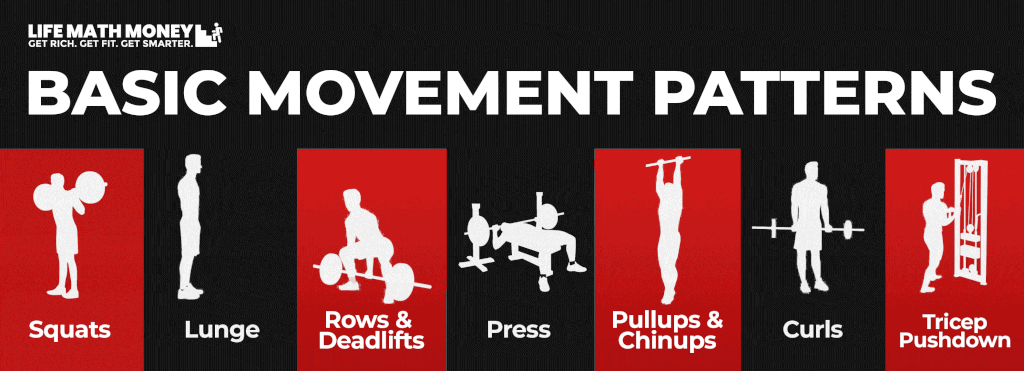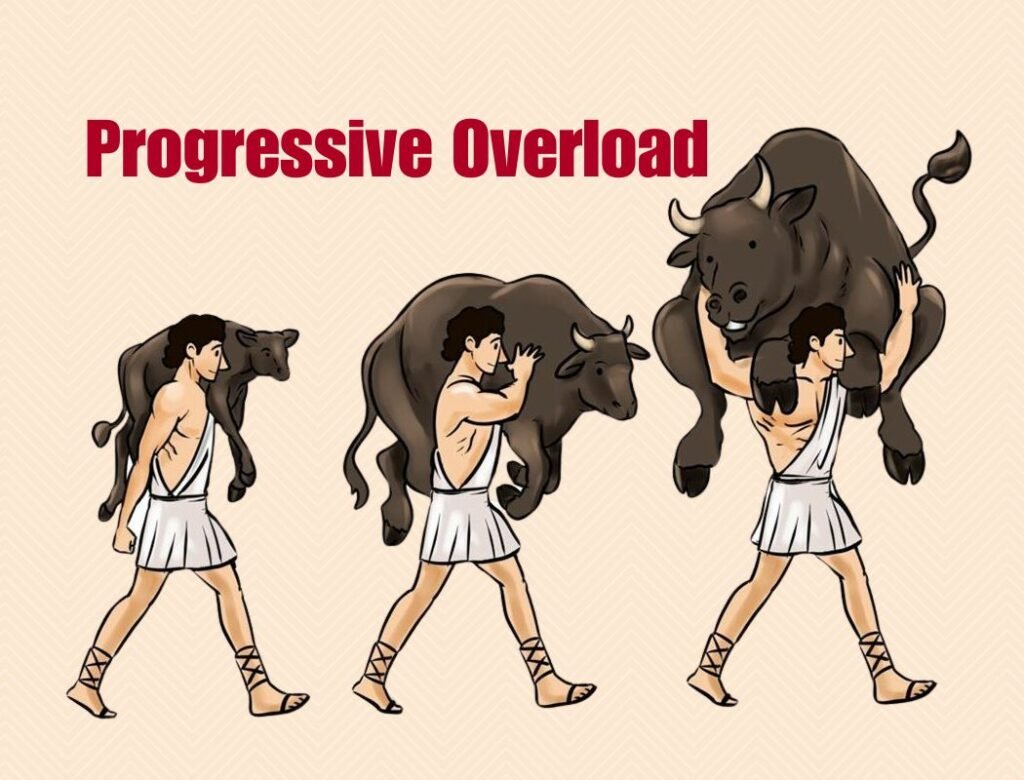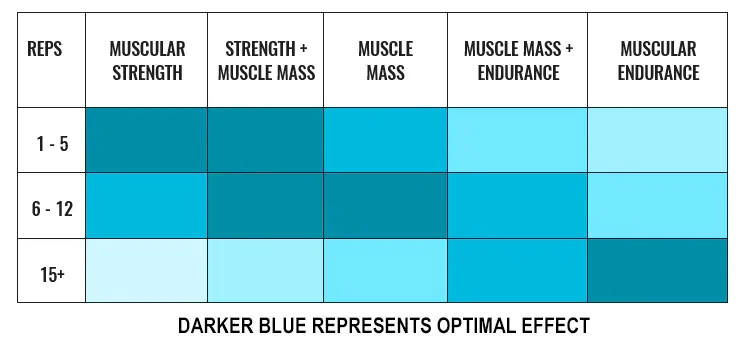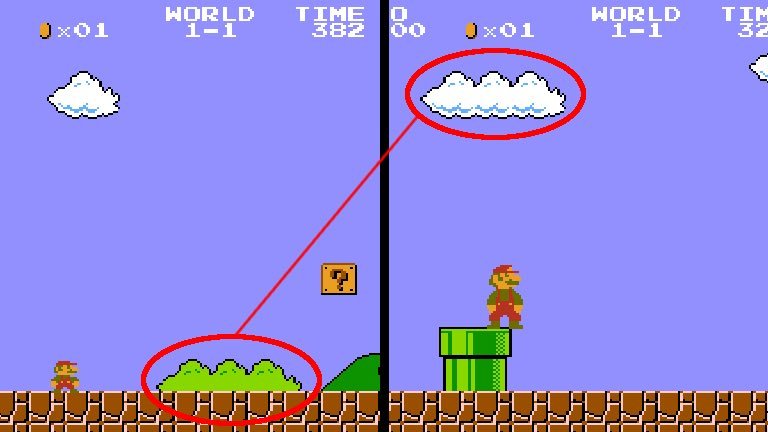Increasing muscle density is a very straightforward process.
Note that straightforward does not mean easy. Gaining muscle density takes effort, time, and most importantly – consistency.
Here are the 6 things you need to do if you want strong dense muscles:
1) Train all the basic movement patterns.
Train all your muscles and do all the basic movement patterns your body is capable of.
There are only a few basic movement patterns (from a strength training perspective):
- Squats – Keep a weight on your back and lift it up (think of how you would lift up a table if you didn’t have hands)
- Lunge – Step over something
- Rows and Deadlifts – Pull something towards yourself; lift something off the ground
- Press – Push something away from you (overhead and horizontal)
- Pullups and Chinups – Pull yourself up to your neck level
- Curls – Grab something by your hands and bring it towards your mouth
- Dips/Tricep pushdown – Pull yourself up from your neck level to your hip level (think the second half of a muscle-up).

Make sure your training program consists of some variation of each movement pattern. If your training program is missing a basic movement pattern, your training program is not complete.
You need to train each movement pattern in some way. If you do not train a movement pattern, you will miss training some muscles of your body and they will not get strong and dense.
Do the main compound movements first and then do isolation exercises to give the most stimulus to your muscles.
For example, if you’re training shoulders – do the overhead press first. Only then move on to the shoulder press machine, lateral raises, front raises, rear delt flies, etc.
First major compound movements, then the isolation movements and the machines.
2) Progressive overload – Always strive to do more than last time.

How do you get stronger and denser muscles? By giving your body a reason to make your muscles strong and dense.
What reason could your body have to make your muscle strong and dense? Lifting heavier loads than last time.
Every time you train, try to do a little more than you did last time. This could be an extra rep, or some extra weight that you lift for each exercise.
Unless you are very beat up or not feeling good, you should always aim to do a bit more than your previous training.
If you squatted 100kg last time for 3 sets of 5 reps, you should aim to do 102kg this time for 3 sets of 5 reps.
You will get stronger denser muscles if you lift increasingly heavier weights because your muscles will have no choice but to get stronger and denser to lift them.
Increase the weights a little each time. 2.5kg per workout is fine for big movements like squats and deadlifts. 1kg per workout is fine for bench and overhead press.
For exercises where small increments are not possible increase reps until you can lift the next weight a few times.
There are two situations where this might happen:
- You are already very strong and are forced to increase weights less frequently. For example, going from 180kg squat to a 182kg squat in 1 workout may be too much. You need to increase reps/volume before you hit the next number. You may only progress in weight once a week or once every 2 weeks instead of every workout. If this is you, look up something called the Texas method.
- The exercise equipment itself limits you to big weight increments. Your gym might have dumbbells that go up by 2-2.5kg each. That’s a total 4-5kg increase every time you want to increment weights, which is too much even for squats and deadlifts, so you obviously can’t do them for isolation exercises like bicep curls.
If you can curl 20kg dumbbells for 8 reps now, bring that up to 10 the next workout, then 12. Then the workout after that, pick up 22kg dumbbells and you’ll probably get in 3-6 reps. Then increase reps until you can curl the 24kg dumbbells a few times. Rinse and repeat.
It is IMPOSSIBLE to not get strong dense muscle this way. Your muscles have to get bigger, stronger, and denser to enable you to do this.
Neurological adaptation (where the same amount of muscle can lift heavier loads as it “learns” the exercise) only gets you so far and the muscles are FORCED to grow to lift the increasing weights.
Note: You need to maintain good form even with the increased weights and reps. If your form is bad or if you cheat the rep with incomplete range of motion, the rep doesn’t count.
3) Use multiple rep ranges

You want to use multiple rep ranges and instead of sticking to only 1 rep range. This way you can train for both strength and size.
There is no magic “hypertrophy range” and there are benefits to training in all rep ranges.
The way to do this is to use different rep ranges for each exercise type. Here is the pattern I recommend:
For major compound movements (like squats and bench): 5-8 reps.
For assistance free-weight and cable exercises (like Bulgarian squats, seated cable rows, tricep pushdowns, etc.): 8-12 reps.
For machines: 12-15 reps.
Do 3-4 sets with each exercise, always striving to do a little more than you did last time. By utilizing multiple rep ranges you build both strength and muscle mass.
4) Eat plenty of calories and protein

Eat plenty of calories and protein. Do not deprive yourself of nutrition.
Unless you are a beginner in the gym, you will not grow muscles in a caloric deficit. Losing fat and building muscle at the same time works for newbies and for people on anabolic steroids.
It does not work for people who are already reasonably strong and big and not on bodybuilding drugs.
You need calories to build muscle. Count your calories and your macros and eat in a slight surplus. Counting calories is very easy and takes 5 minutes a day so do it.
A 300 calorie surplus is more than sufficient for most people. Do not overeat because you want to gain muscle density, not become fat.
Perma-bulks are dumb and the people who do them look like shit regardless of how strong they are.
Keep your diet clean. Dirty bulking works if you are on gear. For natural trainees, you only get fatter.
Recommended Macro-Nutrient Breakdown

For protein, aim for 2g per kg bodyweight. This is a good metric for lean people.
If you are fat, the 2 grams per kg bodyweight will give you an absurdly high number. In that case, you can eat your height in cm. So if you are 180cm tall, aim to eat 180g protein per day.
Protein is the building block of muscle. To get dense muscle, you need to eat lots of protein. If you eat very little protein, you simply are not giving your body the “raw material” to grow.
Make sure you get most of your protein from high quality sources. Animal protein like meat and dairy is superior to plant protein like pulses and lentils.
If you are a vegetarian, read the classic LMM article on how to increase protein in an Indian vegetarian diet.
Alternatively, just use my 200g protein in 2000 calories meal plan and modify as needed.
For fat, aim for 0.75 gram for each kg of bodyweight.
If you are overweight, aim for roughly 0.375 times your height in cm because the grams-per-kg-bodyweight will give you insanely high numbers.
Eating fat is important to maintain good hormone balance and prevent a big drop in testosterone levels.
For the rest of your calories, eat carbohydrates. Do not deprive your body of carbohydrates.
Unless you are insulin resistant, diabetic, or live a sedentary life (outside the gym), you do not need to be afraid of carbohydrates.
Carbs/glycogen are the preferred source of energy for your muscles so give your body as much as they needs. Make sure to keep your carbohydrate consumption around your workout.
5) Rest days and sleep 8 hours a day.

Schedule rest days in your program. You want a rest day at least once a week, preferably twice a week.
Rest days ensure that you are rested and recovered enough to be able to lift slightly more weight than last time (progressive overload is the main driver of growth). If you do not have rest days, you will eventually plateau because you do not give your muscles enough time to recover.
You also need to sleep. Sleep is when recovery and growth happens.
You want to sleep at least 8 hours on most days. If you are regularly staying up late chatting with women, partying, playing video games, or some other nonsense like that – you are compromising your recovery.
Do not stay up late at night regularly if you want to maximize muscle growth. Without rest, everything will eventually stall. In fact, your lifts might actually start going down instead of up.
Remember that you don’t actually build muscle in the gym. You only give it stimulus to grow in the gym. The muscle is built when you are recovering – resting and sleeping.
6) Show up to the gym consistently.

Finally, if you want strong and dense muscle, you need to show up to the gym consistently.
Have a program and show up at least 4-5 days a week.
3 days is minimum and 6 is usually too much for most people. If you’re in the gym 7 days a week, you’re compromising your gains by not having any rest and recovery days.
Don’t skip workouts just because you “don’t feel like it”. That’s what unserious people do.
Unserious people also look exactly the same no matter how many “years” they’ve been training for. You see him today and 1 year later, and he’ll look exactly the same. No real physical progression.
I have been training for a long while and I can tell you – if you get these 5 things right, you WILL grow strong and dense muscle. It is next to impossible not to grow muscle if you are:
- Training all muscle patterns
- Progressively overloading all your lifts
- Using all the main rep-ranges
- Getting enough calories and protein
- Getting enough sleep and scheduling rest days in your program
- Showing up to the gym consistently
Increasing muscle density and size is really that simple.
People who fail to get results in the gym are almost always not doing at least one of these things right. But not you anymore, because now you know.
So get at it my brother. Hit the gym and lift some heavy weight.
I’ll see you there.
Your man,
Harsh Strongman
P.S. Note that there is one situation where this guide will not work for you and that is if you are severely hormonal compromised. If your testosterone is absurdly low (350 or below) and if natural remedies and lifestyle changes don’t fix it, you need to see an endocrinologist and will probably need testosterone replacement therapy (TRT).










![Traits Women Find Attractive Traits Women Find Attractive (And How to Score Yourself) [PART 1: Physical Aspects]](https://lifemathmoney.b-cdn.net/wp-content/uploads/2025/11/Traits-Women-Find-Attractive-1.jpg)







































































